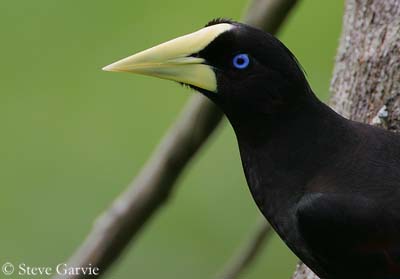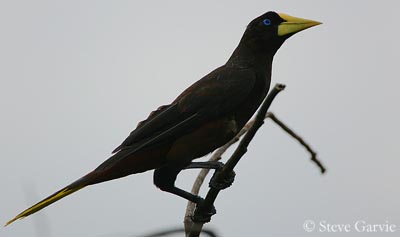
Crested Oropendola
Psarocolius decumanus
Passeriforme Order – Icteridae Family
BIOMETRICS :
Length: 43 cm
Weight: M: 300g – F: 180g
DESCRIPTION:
Crested Oropendola is a medium-sized bird.
Adult male has black plumage almost overall. Rump, upper and under tail feathers are chestnut. Several scapulars may be edged with chestnut. Black thighs are washed with chestnut.
Tail is bright yellow with two black central tail feathers, which are shorter than others, that forms yellow edge around these black rectrices.
Head is black, with thin black crest visible when bird is excited. Strong, conical bill is pale yellow or ivory. Eyes are turquoise-blue. Legs and feet are black.
PROTECTION / THREATS / STATUS:
Crested Oropendola is not endangered. Populations are stable but not so big. Their tropical habitat is regularly reduced by human developments.
Fr: Cassique huppé
All : Krähenstirnvogel
Esp : Conoto Yapú
Ital : Oropendola dal ciuffo
Nd : Kuif-oropendola
Photographs by Steve Garvie
HIs website : RAINBIRDER Photo galleries
Text by Nicole Bouglouan
Sources:
NEW WORLD BLACKBIRDS – THE ICTERIDS by Alvaro Jaramillo and Peter Burke – Helm - ISBN : 0713643331
A GUIDE TO THE BIRDS OF COLOMBIA by Steven L. Hilty and William L. Brown - Princeton University Press – ISBN 069108372X
Wikipedia (Wikipedia, The Free Encyclopedia)
Arthur Grosset's Birds (Arthur Grosset)

Adult female is similar, but smaller (37 cm) and duller, more brownish-black than male. Wings are shorter and more rounded. Crest is more reduced than in male.
Juvenile is similar to female but duller. Bill is rather brownish, as the eyes. We can also see narrow brown or chestnut-brown edges in scapulars, back and underparts.
We find four subspecies:
P.d. decumanus, from Colombia to Amazon and Brazil.
P.d. melanterus, from Panama and West Colombia.
P.d. insularis, of Trinidad and Tobago.
P.d. maculosus breeds south of the Amazon.
VOICE: SOUNDS BY XENO-CANTO
Crested Oropendola is almost silent outside of breeding season. During breeding and nesting periods, we can hear several kinds of calls and songs.
Courtship displays are accompanied by liquid, vibrating, ascending and descending “cr-crreeeEEEooooooooooo”, sometimes ending with one or two lower notes. Other sounds come from the beating wings after the song.
In territorial displays, male utters a gurgling rattle and a liquid sound “crrrrr-ooooo-whooop-whooop”, or a hoarse “tsreee-kleee”.
This species utters different and variable songs, according to the geographic range, and sometimes, songs can be individual.
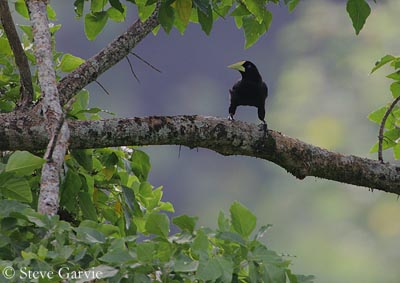
HABITAT:
Crested Oropendola lives in forest edges and clearings. It can be found in cultivated areas and plantations, and at the edges of mature tropical forests. Its habitat may be variable, but it needs tall nesting trees, mainly isolated from the rest of woodlands.
It may be found in dense bamboo thickets where it roosts.
This species avoids arid areas, but may inhabit urban areas.
RANGE:
Crested Oropendola is resident breeder in South America east of the Andes, from Panama and Colombia, southwards to northern Argentina, and also in Trinidad and Tobago. Outside breeding season, it performs some seasonal movements.
BEHAVIOUR:
Crested Oropendola can be seen alone or foraging in small groups. It forages on the ground searching for insects, fruits and seeds, mainly at forest edges. But this species forages mainly in mid or upper level in trees, where it feeds on nectar from flowers, such as Erythrina trees, family of Fabaceae. Crested Oropendola performs some acrobatic movements, probing and searching invertebrates on the underside of leaves.
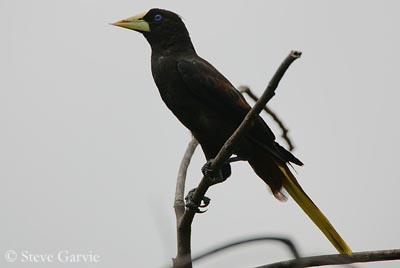
Crested Oropendola roosts in large flocks at night, often in dense Bamboo thickets. During breeding season, males sleep at communal roost, while female incubates the eggs at nest.
Crested Oropendola is highly polygamous. In some parts of the range, a colony may include about 15 to 30 females, and only 3 to 4 males. There is a dominant male, which is often the “father” of most of the young in a colony.
Male performs elaborated bow display. When perched, male bows forwards with head lower than perch level. Wings are extended and over back, where they are vibrating. Tail is erect forwards while male is bowing, sometimes nearly ending upside down. Then, tail is lowered and wings flap slowly until stopping, and bird recovers normal position. During these displays, Crested Oropendola erects its black crest.
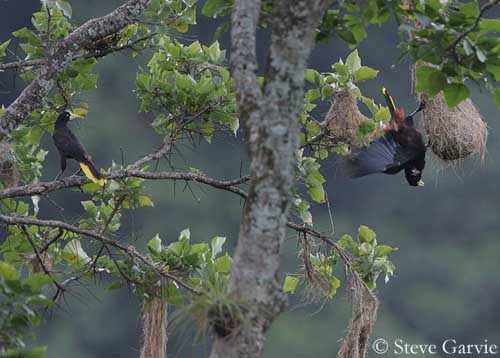
Territorial displays given to males are less elaborated and vocalizations are different and shorter. When at nest-site, male performs noisy flights from perch to perch. Noise is provided by the pointed primaries of adult male.
Copulation occurs at nest or very close. Female approaches male with plumage pressed on her body. She raises head and tail, and flutters her wings. Male fluffs up its neck feathers, and performs snapping bill and fluttering wings. Copulation is short, and then, they preen before flying off.
FLIGHT:
Crested Oropendola is highly mobile, although non-migratory.
REPRODUCTION:
Crested Oropendola nests in colonies from 2 to 30 nests in tall trees, up to 25 to 30 metres above the ground. Breeding season occurs from November to April.
Nests are mainly in isolated tree, which canopy does not touch that of close tree, in order to protect the colony against predators such as snakes and monkeys. They can use these nests year after year.
Nest is a long, hanging basket (up to 125 cm long, maybe more) with an entrance on the top. It is woven with varied materials such as palm fibres, bark strips, roots and coconut fibres. Female builds the nest.
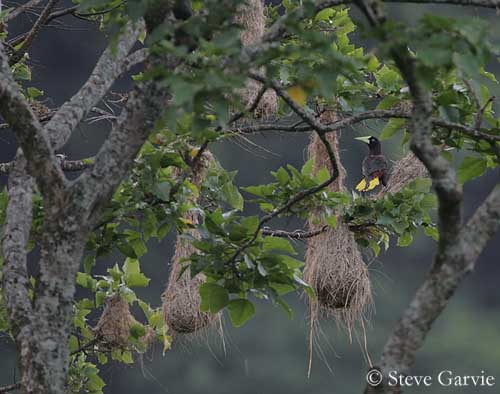
Female lays 1 or 2 bluish-grey eggs, with dark spots. Incubation lasts about 15 to 19 days. Young fledge about one month after hatching, five weeks in some parts of the range.
Nest may be parasitized by Giant Cowbirds and Shiny Cowbirds, but any young have been seen observed to fledge.
DIET:
Crested Oropendola feeds mainly on insects, seeds, grain, fruits and nectar from flowers.
